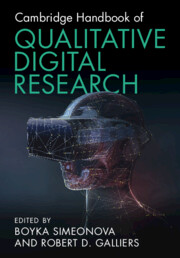Book contents
- Cambridge Handbook of Qualitative Digital Research
- Cambridge Handbook of Qualitative Digital Research
- Copyright page
- Contents
- Figures
- Tables
- Contributors
- Preface
- Part I Philosophical, Epistemological and Theoretical Considerations
- Part II Methodological Considerations
- Chapter 7 Human Values in a Digital-First World: The Implications for Qualitative Research
- Chapter 8 One Picture to Study One Thousand Words
- Chapter 9 Demystifying the Digital
- Chapter 10 Case Study Research Revisited
- Chapter 11 Social Media Qualitative Research Vignettes
- Chapter 12 Co-Inquiring in a Digital Age
- Part III Illustrative Examples and Emergent Issues
- Index
- References
Chapter 10 - Case Study Research Revisited
from Part II - Methodological Considerations
Published online by Cambridge University Press: 08 June 2023
- Cambridge Handbook of Qualitative Digital Research
- Cambridge Handbook of Qualitative Digital Research
- Copyright page
- Contents
- Figures
- Tables
- Contributors
- Preface
- Part I Philosophical, Epistemological and Theoretical Considerations
- Part II Methodological Considerations
- Chapter 7 Human Values in a Digital-First World: The Implications for Qualitative Research
- Chapter 8 One Picture to Study One Thousand Words
- Chapter 9 Demystifying the Digital
- Chapter 10 Case Study Research Revisited
- Chapter 11 Social Media Qualitative Research Vignettes
- Chapter 12 Co-Inquiring in a Digital Age
- Part III Illustrative Examples and Emergent Issues
- Index
- References
Summary
The chapter re-examines the case study research method and its role and contribution to the IS discipline and focuses on the current status of the case study research and the increased digitalization. The advantages of qualitative interpretive cases studies are identified, recent case studies are described and analyzed, and their contributions highlighted. These examples continue to enhance the discipline and sustain the traditional benefits of the case study research through rich data, analysis and understanding the links between people, organizations and technologies, the advancement and expansion of theory, the identification of hidden aspects, and the emergence of new concepts and theorization. Two of the cases use trace data, a type of data emerging as a product of digitalization. While these cases provide contributions, they also challenge the traditional understanding of what a case study is, and the benefits that accrue. The chapter emphasizes the need for mixed-method and multi-method case studies research in addition to trace data to enhance the benefits of the case study research.
Keywords
- Type
- Chapter
- Information
- Cambridge Handbook of Qualitative Digital Research , pp. 140 - 159Publisher: Cambridge University PressPrint publication year: 2023

